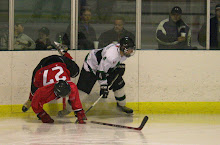
Athletes often rely on cross-training to better condition their bodies and minds to compete at a higher level. I think that photographers too can also do the same thing to hone both their physical and mental skills. I am in the wedding photography business, but I always take the opportunity to shoot sports events: at this time of year it happens to be hockey. Shooting sports requires you to follow the action and that means you have to hold your camera up to your eye, your finger on the button, ready to shoot. This builds your upper body strength and it trains your mind to concentrate on what's going on in front of you.
One of the most important skills you hone is the ability to anticipate the action. Photographing a hockey player carrying a puck down the ice isn't all that heart-stopping, but catching an opponent driving him sideways into the boards with a heavy body check can yield some pretty impressive images. I shoot on continuous mode which means an average Jr. C hockey game can deliver over 1,000 images. My goal is to come up with three that are worthy of a front page. Of those, one will be truly stellar.

